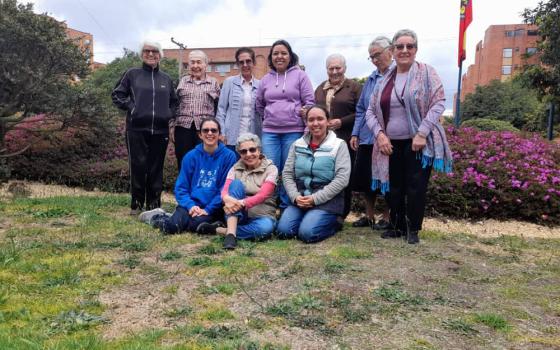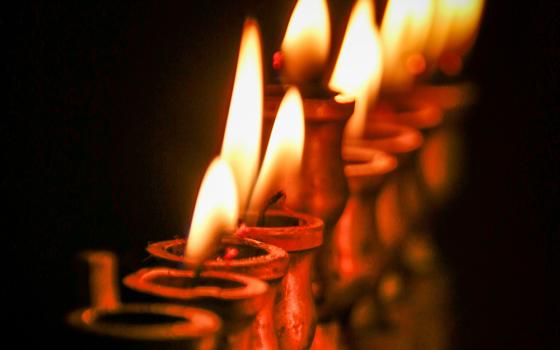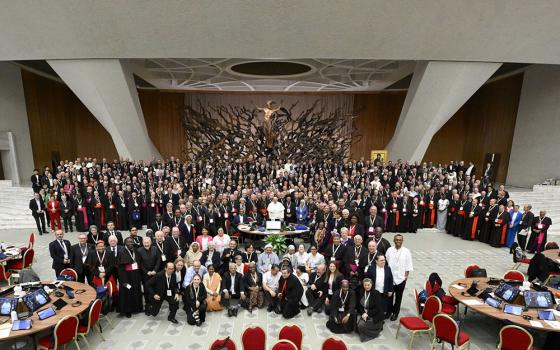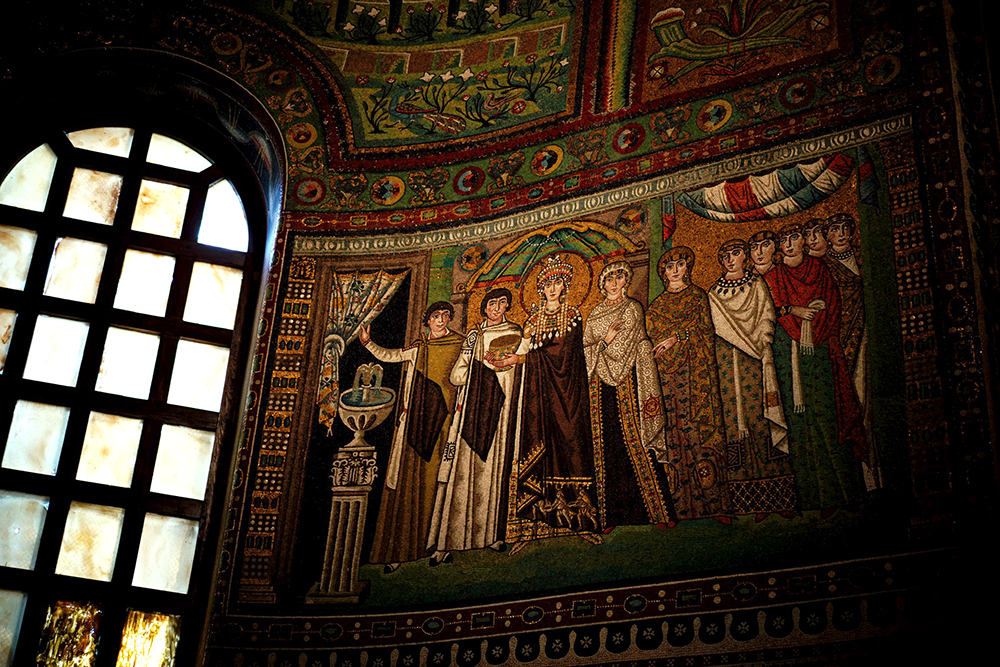
A mosaic of the liturgical procession of Theodora and her imperial court located at the Church of San Vitale, in northwestern Ravenna, Italy. (Wikimedia Commons/O0OKO0o)
Who is not familiar with the problem of male clericalism in the Catholic Church!? It is repeatedly mentioned by Pope Francis and never missed in any document that reflects the sensus fidelium. In fact, it has become a big challenge for formators in seminaries.
An increasing number of feminists, especially those in consecrated life, do not seem to wholeheartedly support the possibility of the diaconate being extended to women in today's church and world. They fear that women deacons would end up becoming the handmaids of priests. Even if they were allowed to preach, their homilies would be censored by some male authority. They would not have the final say in major decision-making processes in the church.
On the other hand, I do not like the idea of doubling the problem of clericalism, which I think would be very likely if women became part of the same power system. I have personally experienced a lot of it, especially among women lay leaders (including feminists) who want to continue in their roles/positions at any cost, thus depriving newer persons of opportunities to serve. This is a known issue in India as women are the majority among lay leaders and have the potential to become deacons. So, the consequences of so many permanent deacons residing and serving permanently in the same parish are imaginable in the long run. This could probably be avoided if consecrated women who are accustomed to transfers became deacons, though.
However, strangely, I feel happy with the thought that maybe women could become something like bishops and cardinals instead. In my opinion, it does not seem necessary that these roles should be fulfilled only by the clergy today. Women, especially those in consecrated life, could be entrusted with the pastoral care of dioceses even if not "ordained" in the contemporary sense. Similarly, they could belong to the College of Cardinals.
Advertisement
Ordination had different meanings in the ancient churches. Initially, it simply meant the inscription in a particular ordo or order or socio-liturgical category. There were various ordines for men as well as women, such as the order of catechumens, order of widows, order of virgins, order of deacons and order of bishops, to name a few.
Liturgically, we have the ordo consecrationis virginum, ordo professionis religiosae, etc., in consecrated life referring to the various rites used for our consecrations/professions. In a way, we are ordained into these vocational categories because of these ceremonies. Over the centuries, these simple meanings of ordination have gone through theological embellishments in favor of patriarchy and male clergy. Moreover, ordination has become associated with power instead of service. Let me elaborate on how this happened.
In the earliest narratives on the evolution of ecclesial ministry, according to scripture and tradition, men and women served the community on their own initiative after having experienced Christ personally. They were enthused by their baptismal calling and evangelized on an equal footing, too. According to my calculated guess, after some research on this, unorganized male and female virgins, as well as widows, seem to have been among the precursors of emerging ministries, such as the diaconate and episcopate (Philippians 1:1).
Jesus is mentioned as a priest only in the Epistle to the Hebrews, which was written much later, compared to other books of the Bible. According to biblical scholars, it was written for persecuted Jewish Christians living in Jerusalem and purposely attributed to Paul so that they would not turn back to Judaism. Hence, I do not think deacons and bishops in each and every church were ritualistic ministers like we see today. Rather, they were appointed with clearly pastoral thrusts; in some churches, the Eucharist was probably presided over by the baptized laity, most likely the hosts of the house churches.
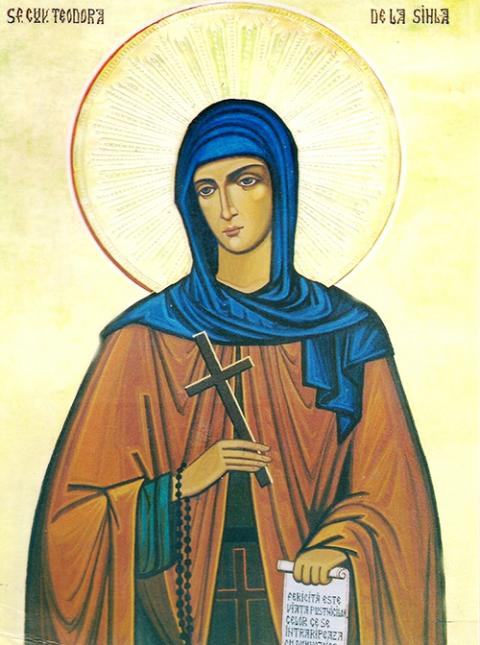
An icon of St. Theodora of Sihla, located in Sihastria Monastery, Romania (Wikimedia Commons)
Moreover, some of the virgins and widows were absorbed into these newer formalized ministries along with married individuals. This could explain why early church artifacts display the presence of married and unmarried men, as well as women in various pastoral offices and liturgical roles. Although there could have been some differences based on the kind of pastoral ministries men and women could more adequately fulfill in their local cultural contexts, there is historical evidence of women bishops in antiquity.
By the end of the fourth century, since persecution had ceased during the Constantine reign, after the Edict of Milan (AD 313), women's leadership in semi-private house churches was gradually replaced by huge church buildings and more institutionalized. The Eastern churches continued appointing women deacons. The vocations of widows and women virgins in the Latin Rite were also organized into somewhat formal categories.
Hence, dedicated widows were enlisted in the ordo viduarum, whereas women virgins who were publicly consecrated by the bishop through a liturgical rite, were ascribed in the ordo virginum. (The consecratory prayer of this rite is found in the earliest sacramentaries and attributed to St. Matthew, the Apostle. It continues to be used even today). These two categories of women were publicly recognized in the dioceses, and issues related to them were frequently raised in church councils over the centuries.
Until the 12th century, the consecration of virgins was considered one of the 12 sacraments. The 13th century saw the impact of scholastic theology, which not only led to their systematization but also officially reduced them to seven sacraments as we know them today. I think this should not have happened as it impacted the theology of ordination, starting a new paradigm that gradually divinized the clergy and made ordination gender exclusive. Moreover, instead of remaining a civil and family event, marriage started being recognized as a sacrament, thereby becoming the cause of all kinds of heated debates in today's church. The ancient churches did not understand sacraments as we do today.
Women, especially those in consecrated life, could be entrusted with the pastoral care of dioceses even if not "ordained" in the contemporary sense.
So also, in medieval times, abbesses of monasteries were regarded as equivalent to bishops in dioceses. Theologically and spiritually, there does not seem to be any reason why women united with Christ in total consecration and dedicated to the service of the church and world could not have presided over the Eucharist, either.
History has been manipulated and shaped by patriarchy. That is why consecrated women's roles seem to be understood in terms of servitude rather than service. Can this be reversed? Would it help if the vestiges of women's participatory roles in the ancient churches were simply copied and pasted into contemporary contexts? How about fresh perspectives, instead?
For example, in some of the other major religions, as in some Hindu traditions, it is not uncommon for the pastoral authority and power to be separated from the ritualistic priesthood. Why not in Catholicism, too? We already have consecrated women serving the mission of the church for two millennia in varied ways. Instead of focusing on reviving the ministry of women deacons and (perhaps) the priesthood, which may not be immune to the problem of clericalism, could the church admit women to the episcopate as a pastoral ministry first? This would benefit the church in many ways, but that's for another column!


